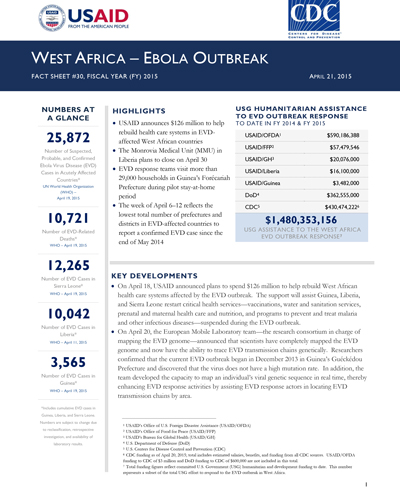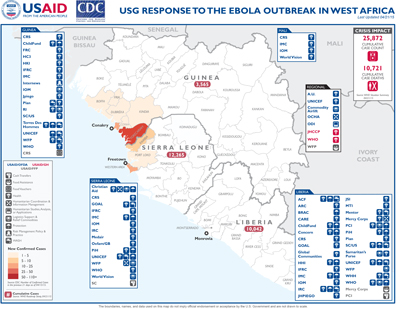April 21, 2015
HIGHLIGHTS
Ebola Response
Visit our main West Africa Ebola Outbreak page to learn more about how we're responding to the West Africa Ebola outbreak, and what you can do to help.
- USAID announces $126 million to help rebuild health care systems in EVD-affected West African countries
- The Monrovia Medical Unit (MMU) in Liberia plans to close on April 30
- EVD response teams visit more than 29,000 households in Guinea’s Forécariah Prefecture during pilot stay-at-home period
- The week of April 6–12 reflects the lowest total number of prefectures and districts in EVD-affected countries to report a confirmed EVD case since the end of May 2014
West Africa Ebola Outbreak Fact Sheet #30 (FY 15) ![]() (pdf - 308k)
(pdf - 308k)
KEY DEVELOPMENTS
- On April 18, USAID announced plans to spend $126 million to help rebuild West African health care systems affected by the EVD outbreak. The support will assist Guinea, Liberia, and Sierra Leone restart critical health services—vaccinations, water and sanitation services, prenatal and maternal health care and nutrition, and programs to prevent and treat malaria and other infectious diseases—suspended during the EVD outbreak.
- On April 20, the European Mobile Laboratory team—the research consortium in charge of mapping the EVD genome—announced that scientists have completely mapped the EVD genome and now have the ability to trace EVD transmission chains genetically. Researchers confirmed that the current EVD outbreak began in December 2013 in Guinea’s Guéckédou Prefecture and discovered that the virus does not have a high mutation rate. In addition, the team developed the capacity to map an individual’s viral genetic sequence in real time, thereby enhancing EVD response activities by assisting EVD response actors in locating EVD transmission chains by area.
REGIONAL
During the week of April 6–12, the number of confirmed cases in EVD-affected West African countries increased to 37 from the previous week’s 30 cases, according to WHO. Guinea recorded 28 confirmed EVD cases in five prefectures, and Sierra Leone’s EVD case incidence remained at nine confirmed cases in three districts. Liberia maintained zero confirmed EVD cases during the same period. The week of April 6–12 reflected the lowest total number of prefectures/districts in EVD-affected countries to report a confirmed EVD case since the end of May 2014.
On April 17, the African Development Bank announced $300 million to support EVD recovery efforts. The new funding will assist national governments in Guinea, Liberia, and Sierra Leone by investing in health, education, water and sanitation, agriculture, and the financial sector. In addition, the African Development Bank is preparing to support both the establishment of the African Centers for Disease Control, as well as the Post-Ebola Livelihoods Restoration Project, which aims to improve the productive capacity of vulnerable EVD-affected populations and increase their access to basic socioeconomic services.
West Africa Ebola Map #30 April 21, 2015 ![]() (pdf - 504k)
(pdf - 504k)
Liberia
The U.S. Public Health Service (USPHS) Commissioned Corps is working to decontaminate and officially close the MMU on April 30. The MMU—which opened to patients on November 7, 2014—had, in total, admitted 42 patients, tested 18 positive for EVD, and discharged nine of those as survivors as of April 15.
In recent weeks, the Government of Liberia (GoL) Incident Management System (IMS) contacted multiple organizations to request assistance decommissioning the Island Clinic, Old Ministry of Defense, and Unity Conference Center EVD treatment units (ETUs) in Montserrado County. In response, WHO provisionally agreed to provide financial and technical assistance to decommission the three facilities. The UN Children’s Fund (UNICEF) also agreed to assist with the removal of liquid and ash waste from the ETU sites.
Médecins Sans Frontières (MSF) plans to officially hand over the ELWA 3 ETU in Montserrado to the GoL in the coming days. The GoL reported plans to relocate staff and resources from the ELWA 2 ETU, as well as equipment and supplies from the MMU, to ELWA 3 and operate the facility as an infectious disease hospital with the ability to convert to an ETU as needed. Following the transfer of staff and resources, the GoL anticipates decommissioning the ELWA 2 facility with support from WHO.
The GoL also reported plans to relocate the SKD Stadium ETU to Montserrado’s Caldwell neighborhood and provide HIV and tuberculosis treatment. Like ELWA 3, the Caldwell facility will maintain the capacity to convert to an ETU, according to the GoL.
On April 20, CDC presented IMS with its proposed plan for the phased implementation of rapid diagnostic tests (RDTs) for EVD in Liberia. The approach includes the evaluation of RDT performance in testing laboratories in Liberia before limited distribution to clinical facilities. CDC recommended that the implementation of RDTs—which detect EVD proteins in blood and other fluids—follow Liberia’s current infection prevention and control (IPC) guidelines for collecting samples from persons with other infectious diseases, including malaria. CDC also noted that RDTs will sometimes produce both false-positive and false-negative results, and the currently used reverse transcription polymerase chain reaction test remains the gold standard for EVD testing suspected patients and deceased bodies.
The Ebola Survivor Network—managed by the GoL Ministry of Health (MoH)—recently mapped available survivor services in Liberia to improve coordination among EVD response actors and identify unmet needs. The GoL MoH identified eight organizations providing EVD survivor services. The services include medical care, psychosocial support, and cash and food assistance. Following the mapping activity, the Ebola Survivor Network reported a need for support services that promote reintegration of survivors into their communities and foster independence and resilience rather than the one-time assistance packages that some organizations provide. Specifically, the network noted the need for policies that deter discrimination and structured, sustainable programs that encourage financial independence, as well as formal education and training opportunities for EVD survivors.
In a recent IMS meeting, MSF presented its integrated model for caring for EVD survivors that comprises physical health, mental health, and community integration. Of the approximately 1,500 EVD survivors in the GoL database, more than 500 received treatment in the MSF-managed ELWA 3 ETU in Montserrado, and MSF continues to operate a free clinic for confirmed EVD survivors. However, MSF reports the need for additional research on post-EVD health issues and increased cooperation among health actors to ensure that survivor needs are met. In addition, the lack of trained specialists, such as psychiatrists and ophthalmologists, poses challenges to assisting EVD survivors, according to MSF.
Sierra Leone
In Sierra Leone, WHO reported the nine new confirmed EVD cases during the week of April 6–12 were identified in the three western districts of Kambia, Port Loko, and Western Area Urban, which includes the capital city of Freetown. WHO noted that the low proportion of laboratory samples that tested EVD-positive—nine of 1338, or less than 1 percent—and the increasing proportion of cases arising among registered contacts are encouraging signs of the ongoing downward trend in EVD case incidence in Sierra Leone.
The International Rescue Committee (IRC) leads the Ebola Response Consortium (ERC) in Sierra Leone. With $4.4 million in support from USAID/OFDA, the ERC is bolstering IPC capacity in peripheral health units (PHUs) throughout the country by training community health care workers and traditional birth attendants to serve as designated EVD screeners at their local PHUs. In addition, ERC partners are working with PHUs to establish EVD screening stations located outside of the facility. Screening activities follow specific IPC guidelines, including the distance between the screener and the patient; protective equipment, such as gloves and face shields, worn by screeners; and procedures for any screened individual that may meet the case definition for EVD. These measures ensure that all individuals coming to PHUs receive proper screening prior to entry. As of March 22, the ERC had supported nearly 1,100 PHUs to establish screening stations and had trained 950 health care workers and traditional birth attendants to conduct screenings.
Guinea
The Government of Guinea (GoG) and WHO reported 28 new confirmed EVD cases, including 17 cases in Forécariah Prefecture, six cases in the capital city of Conakry, three cases in Coyah Prefecture, and one case each in Boffa and Kindia prefectures, between April 6 and 12—a 33 percent increase from the 21 new confirmed cases reported the previous week. Five prefectures in Guinea reported at least one confirmed EVD case during the same week—one less prefecture than the previous week, according to WHO.
During the first three days of the April 12–15 stay-at-home campaign piloted in Forécariah, EVD response teams visited more than 29,000 households and identified and tested 23 suspected EVD cases, according to WHO. The GoG is planning to conduct similar stay-at-home operations in Boffa, Conakry, Coyah, Dubréka, and Kindia prefectures in the coming weeks.
On April 17, a number of EVD response actors—including representatives from the GoG MoH, the UN Mission for Ebola Emergency Response, the UK Department for International Development, CDC, USAID/OFDA, the International Organization for Migration (IOM), WHO, and the non-governmental organization Action Contre le Faim (ACF)—convened in Conakry to provide updates on their activities to mitigate cross-border transmission. USAID/OFDA partner ACF is evaluating how Guinean EVD response actors can learn from cross-border cholera surveillance programs. CDC is currently working with Guinea’s National Institute for Statistics and WHO to map contact-tracing data with sub-prefectural geographic information. The mapping exercise will provide a visual representation of health care facilities and EVD cases on a sub-prefectural level to enhance contact tracing and case management activities. Also, with support from USAID/OFDA, IOM is evaluating its existing cross-border surveillance programs and is planning to install additional monitoring control points on the Guinea–Sierra Leone border.
PUBLIC DONATION INFORMATION
- The most effective way people can assist relief efforts is by making cash contributions to humanitarian organizations that are conducting relief operations. A list of humanitarian organizations that are accepting cash donations for disaster responses around the world can be found at www.interaction.org.
- USAID encourages cash donations because they allow aid professionals to procure the exact items needed (often in the affected region); reduce the burden on scarce resources (such as transportation routes, staff time, and warehouse space); can be transferred very quickly and without transportation costs; support the economy of the disaster-stricken region; and ensure culturally, dietary, and environmentally appropriate assistance.
More information can be found at:
- The Center for International Disaster Information: www.cidi.org or +1.202.821.1999.
- Information on relief activities of the humanitarian community can be found at www.reliefweb.int.
USAID/OFDA bulletins appear on the USAID website at what-we-









Comment
Make a general inquiry or suggest an improvement.